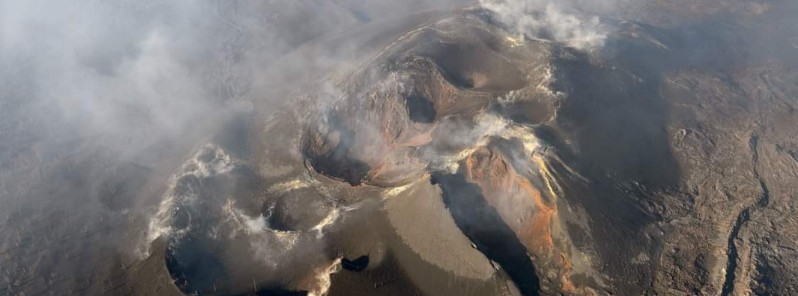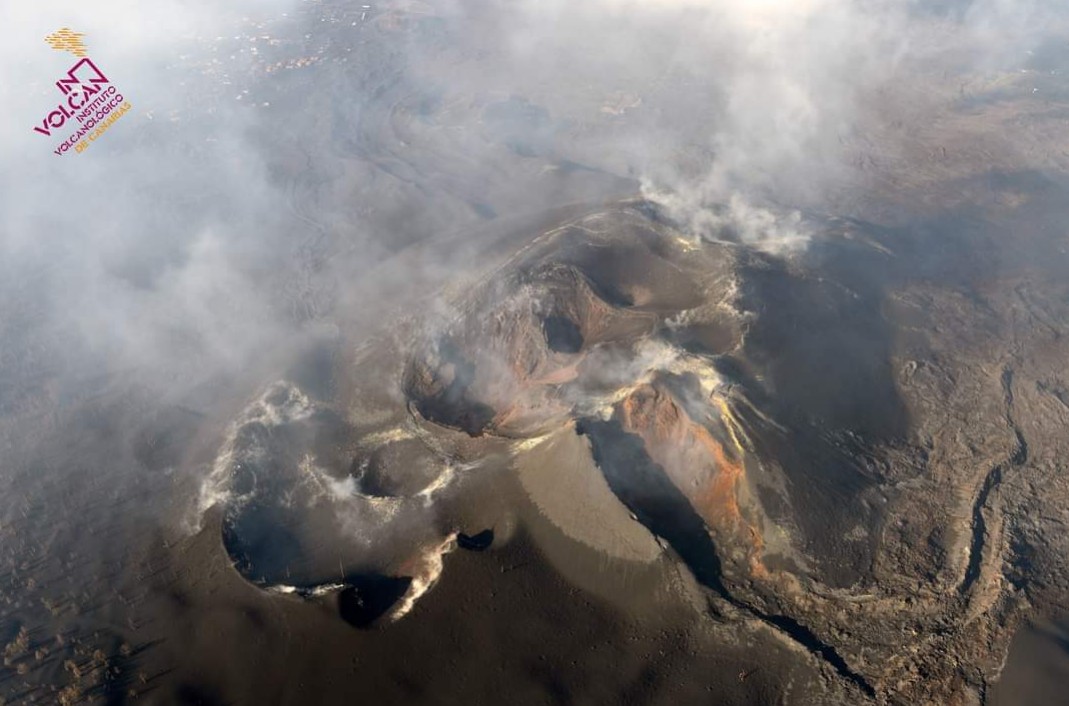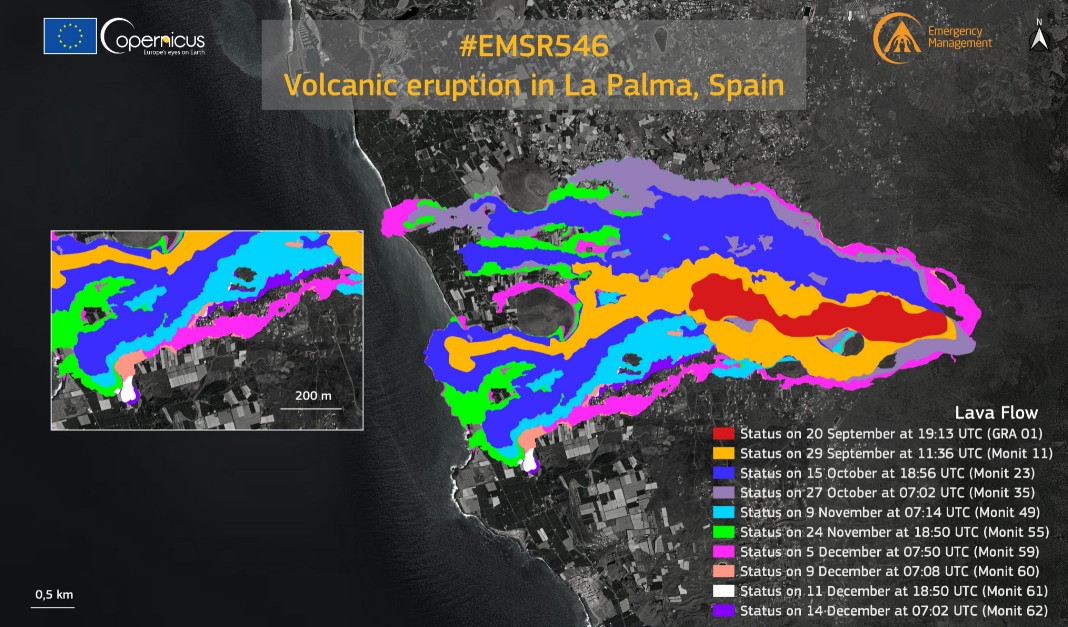Eruption at Cumbre Vieja over after 85 days and thousands destroyed buildings, La Palma

The eruption at Cumbre Vieja volcano in La Palma, Canary Islands, Spain was declared officially over on December 25, 2021 (VEI 3).
- With 85 days of eruptive process and 1 219 ha (3 012 acres) of land covered, this is now La Palma's longest eruption in 375 years of the island's historical data. The second-longest eruption was that of the Tajuya volcano in 1585, which lasted 84 days and covered 480 ha (1 186 acres) of land.
- About 7 000 people, of the islands 83 000, were forced to evacuate.
- Luckily, no injuries or deaths have been directly linked to the eruption.
The island now has a new volcanic building, 200 m (655 feet) high on its base (or about 1 100 m / 3 600 feet above sea level), with at least 6 craters.
Lava has covered about 1 219 ha (3 012 acres) of the island and the average estimated thickness is 12 m (39 feet), with a maximum of 70 m (229 feet). The maximum temperature measured in lava has been 1 140 °C (2 084 °F).
The subaerial area of the lava deltas is 48 ha (118 acres) — 43.46 ha (107 acres) for the southern delta and 5.05 ha (12.4 acres) for the northernmost delta. The estimated underwater surface of the lava deltas is over 21 ha (51.8 acres).

Image credit: INVOLCAN (December 2021)
The eruption started on December 19, spewing rivers of lava that destroyed 2 988 buildings, including homes, schools, churches, and health centers, according to the Copernicus EMS satellite-based estimation.
According to the Cadastre, 1 676 buildings were affected, of which 1 345 residential, 180 agricultural, 75 industrial, 44 for leisure and hospitality, 16 for public use, and the remaining 16 for other uses.
Cadastre data shows 370 ha (914 acres) of affected crops – 228.69 (565 acres) of banana fields, 68.05 ha (168 acres) of vineyards, and 27.43 ha (67.8 acres) of avocados.
To these data, we must add 90 ha (222 acres) of isolated crops. In addition, 412 ha (1 018 acres) of banana trees have been covered by ashes, 128 ha (316 acres) of vineyards, and 84 ha (207 acres) of avocados.
Banana plantations account for nearly 50% of the island's economy.
73.8 km (45.8 miles) of roads have been affected, 10.8 km (6.7 miles) of streets, 2.1 km (1.3 miles) of crossing, and 49.9 km (31 miles) of other roads.

Lava flow extent as of December 14, 2021. Image credit: Copernicus EU/EMS.
"I have searched for the exact word that could define our state of mind. It is not joy, I cannot say that we are happy, and it is not satisfaction either," said the Minister of Public Administration, Justice and Security of the Government of the Canary Islands.1
"Today we feel relief. We can also add the word emotion, although we must also add the word hope. This unbearable litany of destruction has ended and now it's time to rebuild, improve, remake and replace."
Damage is expected to exceed 1 billion USD, but the authorities pledged to help La Palma build after the disaster.
"We will continue working together, all the institutions, to relaunch the wonderful island of La Palma and repair the damage caused," Spanish Prime Minister Pedro Sanches said.
While the eruption is now over, this doesn't mean there is no longer any danger as toxic gases will continue to be released for a long time.
"The emergency has not ended and that PEVOLCA remains on a red light since the risks associated with gases and heat still persist," said Julio Pérez, the director responsible for the PEVOLCA Plan. (PEVOLCA – Special Plan for Civil Protection and Emergency Assistance for Volcanic Risk of the Canary Islands.)
"Surveillance and monitoring will continue throughout the area, but we will start from Monday to study the rehousing plan, which will have to be a safe and orderly rehousing, gradual, in the least affected areas first, and those most affected later," Pérez said, adding that the purpose of those responsible for the emergency is to begin with the first relocations during the first half of January, a period in which it is also intended to begin with the first lava tests which will allow restoring of some of the essential services affected by the eruption.
The PEVOLCA Scientific Committee concluded that the eruption of the volcano that originated in Cabeza de Vaca has been strombolian fissure with phreatomagmatic pulses and with Volcanic Explosivity Index of 3.
In total, six craters have been created and the average length of the base of the building has been 700 m (2 296 feet). The dimension of the largest crater has been 172 m (564 feet) in the major axis and 106 m (347 feet) in the minor.
The estimated volume of the lava building is 34 million m3 and the estimated volume of the total emitted material is greater than 200 million m3.
The maximum range of the ballistic projectiles has been 1.5 km (0.93 miles).
Geological summary
The 47 km (29 miles) wedge-shaped island of La Palma, the NW-most of the Canary Islands, is composed of two large volcanic centers. The older northern one is cut by the massive steep-walled Caldera Taburiente, one of several massive collapse scarps produced by edifice failure to the SW.
The younger Cumbre Vieja, the southern volcano, is one of the most active in the Canaries.
The elongated volcano dates back to about 125 000 years ago and is oriented N-S. Eruptions during the past 7 000 years have originated from the abundant cinder cones and craters along the axis of Cumbre Vieja, producing fissure-fed lava flows that descend steeply to the sea.
Historical eruptions at La Palma, recorded since the 15th century, have produced mild explosive activity and lava flows that damaged populated areas.
The southern tip of the island is mantled by a broad lava field produced during the 1677-1678 eruption. Lava flows also reached the sea in 1585, 1646, 1712, 1949, and 1971.2
References:
1 La erupción de La Palma se declara finalizada tras 85 días y 8 horas de duración y 1.219 hectáreas de coladas – DSN
2 Cumbre Vieja – geological summary – GVP
Featured image credit: INVOLCAN

Anyone who’s read “Through the Curtain” by the above will understand this uptick has been known about in various circles for decades, if not further back. Not only that, the uptick will accelerate in pace, scale to a culmination. Prepare.
summin is up..bigger party and more fireworks coming grab your
sombreros.. from 1 to 6 craters now..these experts have degrees in stupidity..
Cumbre Vieja is similar to Fagradalsfjall volcano, which will erupt again soon after the earthquakes swarm that started just one day after the eruption that began on March 19, 2021 was declared officially over. Both volcanoes are hot spot volcanoes and hot spot volcanoes will explode in 2022 for sure
The eruptions will restart soon and will be far worse than the previous ones
Famous Last Words!
It’s not ‘over’!